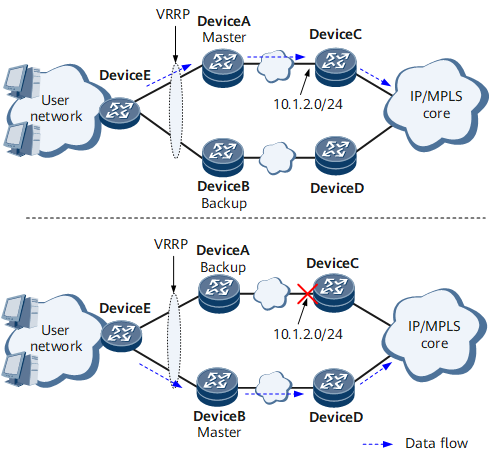Association Between VRRP and Route Status
Context
To improve device reliability, two user gateways working in master/backup mode are connected to a Layer 3 network, and VRRP is enabled on these gateways to determine their master/backup status. After a VRRP group is configured, if an uplink route to a network becomes unreachable due to an uplink failure or topology change, user hosts are unaware of the change, causing service traffic loss.
Association between VRRP and route status can resolve this problem. If the uplink route is withdrawn or becomes inactive, the VRRP group is notified of the change, adjusts its master device's VRRP priority, and performs a master/backup VRRP switchover. This ensures that user traffic can be forwarded along a properly functioning link.
Implementation
A VRRP group can be configured to track an uplink route to determine whether the route is reachable. The VRRP priority of the master device decreases by a specified value. A backup device with a priority higher than others preempts the Master state and takes over traffic. This process ensures communication continuity between these hosts and the external network. After the uplink recovers, the RM module instructs VRRP to restore the master device's VRRP priority.
In Figure 1, a VRRP group is configured on DeviceA and DeviceB. DeviceA is the master and forwards user-to-network traffic, and DeviceB is the backup. DeviceA in the VRRP group is configured to track the 10.1.2.0/24 route.
When the uplink between DeviceA and DeviceC fails, the route to 10.1.2.0/24 becomes unreachable. As such, DeviceA reduces its VRRP priority by a specified value so that its new priority is lower than the priority of DeviceB. DeviceB immediately preempts the master role and takes over traffic forwarding, thereby preventing user traffic loss.
VRRP device configurations are as follows:
- DeviceA functions as the master in the VRRP group with a priority of 120.
- DeviceB works in immediate preemption mode and functions as the backup in the VRRP group with a priority of 100.
- DeviceA tracks the 10.1.2.0/24 route and reduces its VRRP priority by 40 if it is notified that the route is unreachable.
The implementation is as follows:
- Normally, DeviceA periodically sends VRRP Advertisement packets to inform DeviceB that it is working properly.
- When the uplink between DeviceA and DeviceC fails, the 10.1.2.0/24 route becomes unreachable, and the VRRP group is notified of the route status change. After receiving this notification, DeviceA reduces its VRRP priority to 80 (120 – 40 = 80). Because the VRRP priority of DeviceB, which is working in immediate preemption mode, is now higher than the priority of DeviceA, DeviceB immediately preempts the master role and sends gratuitous ARP packets to allow DeviceE to update address entries.
When the faulty link recovers, the 10.1.2.0/24 route becomes reachable again. DeviceA then restores its VRRP priority to 120 (80 + 40 = 120), preempts the master role, and sends VRRP Advertisement and gratuitous ARP packets. After DeviceB receives the Advertisement packet carrying a priority higher than its own, it switches to the Backup state.
- Both DeviceA and DeviceB are restored to their original states. As such, DeviceA forwards user-to-network traffic again.
The preceding process shows that association between a VRRP group and an uplink route can prevent traffic loss. In situations where the uplink route is unreachable, the VRRP group triggers a master/backup VRRP switchover through priority adjustment so that the backup device can take over user-to-network traffic.
Benefits
Association between VRRP and route status helps implement a master/backup VRRP switchover when an uplink route to a network is unreachable. It also ensures that the VRRP group performs a master/backup VRRP switchback, minimizing traffic interruption duration.
Compared with association between VRRP and interface status, association between VRRP and route status can detect not only faults of the directly connected uplink interface, but also device and link faults when uplink traffic traverses multiple devices.
